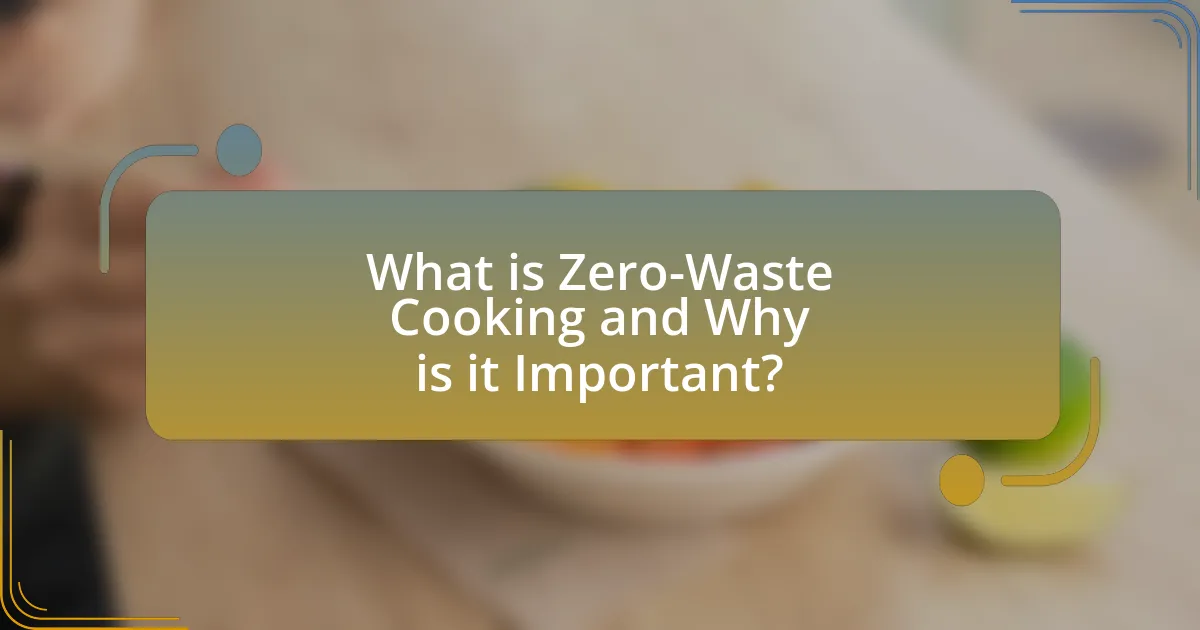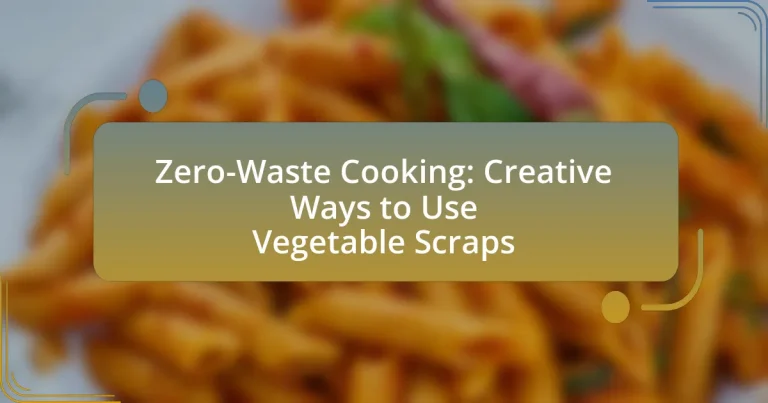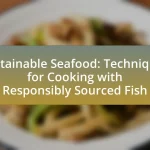Zero-waste cooking is a sustainable culinary practice that focuses on minimizing food waste by utilizing all parts of ingredients, particularly vegetable scraps. This approach is crucial for reducing the environmental impact of food waste, which contributes significantly to greenhouse gas emissions. The article explores the relationship between zero-waste cooking and sustainability, the environmental consequences of food waste, and practical methods for incorporating vegetable scraps into meals. It also provides innovative recipes, storage tips, and tools that enhance zero-waste cooking, while addressing common challenges and misconceptions associated with this practice. By adopting these strategies, individuals can contribute to a more sustainable food system and reduce their overall waste.

What is Zero-Waste Cooking and Why is it Important?
Zero-waste cooking is a culinary approach that aims to minimize food waste by utilizing all parts of ingredients, particularly vegetable scraps. This method is important because it not only reduces the environmental impact associated with food waste, which contributes to greenhouse gas emissions, but also promotes sustainability by encouraging resourcefulness in the kitchen. According to the Food and Agriculture Organization, approximately one-third of all food produced globally is wasted, highlighting the need for practices like zero-waste cooking to combat this issue effectively.
How does Zero-Waste Cooking relate to sustainability?
Zero-Waste Cooking directly supports sustainability by minimizing food waste and promoting resource efficiency. This cooking approach encourages the use of all parts of fruits and vegetables, thereby reducing the amount of organic waste sent to landfills, which contributes to greenhouse gas emissions. According to the Food and Agriculture Organization, approximately one-third of all food produced globally is wasted, highlighting the significant environmental impact of food waste. By adopting Zero-Waste Cooking practices, individuals can contribute to a more sustainable food system, conserve resources, and reduce their carbon footprint.
What are the environmental impacts of food waste?
Food waste significantly contributes to environmental degradation, primarily through greenhouse gas emissions and resource depletion. When food is discarded, it often ends up in landfills, where it decomposes anaerobically, producing methane, a potent greenhouse gas that is over 25 times more effective at trapping heat in the atmosphere than carbon dioxide over a 100-year period. According to the Food and Agriculture Organization (FAO), approximately 1.3 billion tons of food waste are generated globally each year, accounting for about 8-10% of total greenhouse gas emissions. Additionally, food production consumes vast amounts of water, land, and energy; wasting food means wasting these critical resources. For instance, it takes about 1,800 gallons of water to produce just one pound of beef, highlighting the extensive resource use associated with food that ultimately goes uneaten.
How can Zero-Waste Cooking contribute to reducing waste?
Zero-Waste Cooking contributes to reducing waste by maximizing the use of all edible parts of ingredients, thereby minimizing food scraps. This cooking approach encourages techniques such as using vegetable peels, stems, and leaves in recipes, which can significantly decrease the amount of food discarded. For instance, studies indicate that approximately 30-40% of the food supply in the United States is wasted, highlighting the potential impact of adopting zero-waste practices. By creatively utilizing these often-overlooked parts, Zero-Waste Cooking not only reduces landfill contributions but also promotes sustainability and resourcefulness in meal preparation.
What are vegetable scraps and why should we use them?
Vegetable scraps are the leftover parts of vegetables that are typically discarded, such as peels, stems, and leaves. Utilizing vegetable scraps is beneficial because it reduces food waste, promotes sustainability, and can enhance flavor in cooking. For instance, vegetable peels can be used to make broths, while leafy greens can be incorporated into salads or smoothies. By using these scraps, individuals can contribute to a zero-waste lifestyle and maximize the nutritional value of their food.
What types of vegetable scraps can be utilized in cooking?
Vegetable scraps that can be utilized in cooking include onion peels, carrot tops, celery leaves, beet greens, and potato skins. These scraps are often rich in nutrients and flavor, making them suitable for stocks, broths, and garnishes. For instance, onion peels can add color and depth to homemade stock, while carrot tops can be blended into pesto. Utilizing these scraps not only reduces waste but also enhances the culinary experience by incorporating additional flavors and nutrients into dishes.
How do vegetable scraps contribute to a zero-waste lifestyle?
Vegetable scraps contribute to a zero-waste lifestyle by providing opportunities for composting, creating broths, and enhancing soil health. By composting vegetable scraps, individuals can reduce landfill waste and produce nutrient-rich soil amendments, which can improve garden productivity. Additionally, using scraps to make vegetable broth minimizes food waste while maximizing flavor in cooking. Research indicates that composting can divert up to 30% of household waste from landfills, demonstrating its effectiveness in promoting sustainability.
What are the creative ways to use vegetable scraps in cooking?
Creative ways to use vegetable scraps in cooking include making vegetable broth, using scraps in stir-fries, and incorporating them into smoothies. Vegetable broth can be made by simmering scraps like onion peels, carrot tops, and celery leaves in water, which extracts flavors and nutrients, resulting in a rich base for soups and sauces. Stir-fries can benefit from scraps such as broccoli stems and beet greens, which add texture and flavor while reducing waste. Additionally, vegetable scraps like spinach stems or carrot tops can be blended into smoothies, providing added nutrition without the need for additional ingredients. These methods not only minimize waste but also enhance the culinary experience by utilizing all parts of the vegetables.
How can vegetable scraps be transformed into broths and stocks?
Vegetable scraps can be transformed into broths and stocks by simmering them in water to extract flavors and nutrients. Common scraps include onion peels, carrot tops, celery leaves, and garlic skins. To create the broth, combine these scraps in a pot with water, add herbs and spices for additional flavor, and simmer for at least 30 minutes to several hours, depending on the desired intensity. This method utilizes the natural flavors of the vegetable scraps, making it an effective zero-waste cooking technique. Studies show that using vegetable scraps can reduce food waste significantly, contributing to sustainable cooking practices.
What are some innovative recipes that incorporate vegetable scraps?
Innovative recipes that incorporate vegetable scraps include vegetable stock made from onion peels, carrot tops, and celery leaves, which utilize leftover parts to create a flavorful base for soups and sauces. Additionally, potato peels can be transformed into crispy snacks by seasoning and baking them, while broccoli stems can be grated and used in slaws or stir-fries, maximizing the use of the entire vegetable. These methods not only reduce waste but also enhance culinary creativity by utilizing parts of vegetables that are often discarded.
How can we effectively store vegetable scraps for later use?
To effectively store vegetable scraps for later use, place them in an airtight container and refrigerate them. This method preserves freshness and prevents spoilage, allowing for later utilization in broths, stocks, or composting. Research indicates that storing vegetable scraps in a cool environment can extend their shelf life by several days, making it a practical approach for zero-waste cooking.
What are the best practices for storing different types of vegetable scraps?
The best practices for storing different types of vegetable scraps include using airtight containers, keeping them in the refrigerator, and labeling them for easy identification. Airtight containers prevent moisture loss and odor transfer, which is crucial for maintaining freshness. Storing scraps in the refrigerator slows down spoilage, as most vegetable scraps can last several days when kept cool. Labeling containers helps in tracking the age of the scraps, ensuring they are used before they deteriorate. For example, carrot tops and celery leaves can be stored together, while onion peels should be kept separate to avoid flavor contamination.
How long can vegetable scraps be stored before they spoil?
Vegetable scraps can typically be stored in the refrigerator for about 3 to 5 days before they spoil. This timeframe is based on the general shelf life of fresh vegetables, which can begin to deteriorate due to moisture loss and microbial growth. For optimal freshness, it is advisable to keep vegetable scraps in an airtight container to minimize exposure to air and moisture, which can accelerate spoilage.
What tools and techniques can enhance zero-waste cooking?
Tools and techniques that can enhance zero-waste cooking include compost bins, food processors, and creative meal planning. Compost bins allow for the recycling of vegetable scraps and other organic waste, turning them into nutrient-rich soil. Food processors enable the efficient chopping and blending of leftover ingredients, maximizing their use in various dishes. Creative meal planning techniques, such as batch cooking and utilizing all parts of vegetables, help minimize waste by ensuring that every part of the ingredient is used effectively. These methods collectively contribute to a more sustainable cooking practice, reducing food waste significantly.
What kitchen tools are essential for maximizing the use of vegetable scraps?
Essential kitchen tools for maximizing the use of vegetable scraps include a sharp knife, cutting board, vegetable peeler, food processor, and compost bin. A sharp knife allows for precise cutting of scraps into usable pieces, while a cutting board provides a stable surface for preparation. A vegetable peeler efficiently removes skins and outer layers, maximizing the edible portions. A food processor can blend or chop scraps into sauces, soups, or pestos, enhancing their utility. Lastly, a compost bin enables the recycling of inedible scraps, contributing to a zero-waste approach. These tools collectively facilitate the creative use of vegetable scraps, promoting sustainability in cooking.
How can meal planning aid in reducing vegetable waste?
Meal planning can significantly reduce vegetable waste by ensuring that only the necessary quantities of vegetables are purchased and utilized. By creating a structured plan for meals, individuals can accurately assess their vegetable needs, minimizing the likelihood of overbuying and subsequently discarding unused produce. Research indicates that meal planning can lead to a 50% reduction in food waste, as it encourages the use of all purchased ingredients before they spoil. This systematic approach not only conserves resources but also promotes the creative use of vegetable scraps, aligning with zero-waste cooking principles.
What are some common challenges in zero-waste cooking?
Common challenges in zero-waste cooking include difficulty in meal planning, limited ingredient variety, and the need for creativity in using scraps. Meal planning can be complex as it requires anticipating the use of all parts of ingredients to minimize waste. Limited ingredient variety often arises from the necessity to use what is available, which can restrict culinary options. Additionally, creativity is essential for transforming vegetable scraps into palatable dishes, which may be daunting for those unfamiliar with innovative cooking techniques. These challenges highlight the need for knowledge and adaptability in zero-waste cooking practices.
How can we overcome the challenges of using vegetable scraps?
To overcome the challenges of using vegetable scraps, individuals can implement techniques such as composting, creating broths, and utilizing scraps in various recipes. Composting transforms vegetable scraps into nutrient-rich soil, reducing waste and enhancing garden health. Making broths from vegetable scraps maximizes flavor and minimizes food waste, as studies show that homemade broths can contain up to 50% more nutrients than store-bought options. Additionally, incorporating scraps into recipes, such as using carrot tops in pesto or onion peels for flavoring, encourages creativity and resourcefulness in cooking. These methods not only address waste management but also promote sustainable cooking practices.
What misconceptions exist about zero-waste cooking?
One misconception about zero-waste cooking is that it requires extensive time and effort, which deters many from adopting the practice. In reality, zero-waste cooking can be efficient and straightforward, as it often involves simple techniques like using vegetable scraps for broths or composting. Research indicates that many individuals can integrate zero-waste practices into their cooking routines without significant time investment, making it accessible for a broader audience.
What practical tips can help in adopting zero-waste cooking habits?
To adopt zero-waste cooking habits, start by planning meals to minimize food waste. Meal planning allows for the efficient use of ingredients, ensuring that all parts of vegetables are utilized. For instance, vegetable scraps like peels, stems, and leaves can be repurposed into stocks or composted, reducing overall waste. Additionally, storing food properly extends its shelf life, which is crucial for preventing spoilage. According to the USDA, approximately 30-40% of the food supply in the United States is wasted, highlighting the importance of these practices. By implementing these strategies, individuals can significantly reduce their kitchen waste while promoting sustainability.

